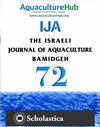使用黑兵蝇幼虫作为泰国蛙的饲料(Rana rugosa Temminck and Schlegel, 1838) -对生产参数影响的初步研究
IF 0.5
4区 农林科学
Q4 FISHERIES
引用次数: 0
摘要
本试验旨在评价日粮中添加新鲜或干燥黑兵蝇幼虫对网箱养殖泰国蛙生产参数和化学成分的影响。初始体重为20.4 g,随机分布在15个网箱(2 × 3 × 1.5 m)中,密度为240个。包括5个饲粮处理:T1(100%商品饲料为对照)、T2(100%干BSFL)、T3(50%干BSFL + 50%商品饲料)、T4(50%新鲜BSFL + 50%商品饲料)和T5(100%新鲜BSFL),每个处理3个重复。结果表明:试验青蛙成活率为64.3% ~ 87.0%,饲料系数提高1.43 ~ 1.90%,活重提高194.7 ~ 244.6 g,日增重提高2.9 ~ 3.7 g.day-1,产量提高6.30 ~ 7.96 kg.m-2。鲜牛油和干牛油对蛙肉粗蛋白质(18.21 ~ 23.19%)、粗脂肪(0.28 ~ 0.53%)和总灰分(0.99 ~ 1.05%)含量均有影响。综上所述,50%新鲜BSFL + 50%商品饲料的饲粮可成功应用于泰国蛙笼养殖。本文章由计算机程序翻译,如有差异,请以英文原文为准。
Using black soldier fly larvae as feed for Thai frog (Rana rugosa Temminck and Schlegel, 1838) – Preliminary study of the effect on production parameters
This study aimed to evaluate the effect of the inclusion of either fresh or dried black soldier fly larvae (BSFL) in diets on the production parameters and chemical composition of Thai frogs ( Rana rugosa ) cultured in net cages. Frog fingerlings have an initial weight of 20.4 g and were distributed randomly into fifteen net cages (2 x 3 x 1.5 m) at a density of 240 frog.net cage-1. Including five dietary treatments named: T1 (100% commercial feed used as a control), T2 (100% dried BSFL), T3 (50% dried BSFL + 50% commercial feed), T4 (50% fresh BSFL + 50% commercial feed), and T5 (100% fresh BSFL) with three replicates for each treatment. The results showed that the survival rate of frogs ranged from 64.3% to 87.0%, improved feed conversion ratio (1.43 to 1.90%), increased live weight (194.7 – 244.6 g), daily weight gain (2.9 – 3.7 g.day-1), and frog’s yield (6.30 – 7.96 kg.m-2). The contents of crude protein (18.21 – 23.19%), ether extract (0.28 – 0.53%), and total ash (0.99 – 1.05%) of frog meat in this study were affected by the inclusion of either fresh or dried BSFL in the diets of frogs. In recommendation, the diet comprised from 50% fresh BSFL + 50% commercial feed could be applied successfully in Thai frog cage production.
求助全文
通过发布文献求助,成功后即可免费获取论文全文。
去求助
来源期刊
CiteScore
0.90
自引率
16.70%
发文量
49
审稿时长
3 months
期刊介绍:
Information not localized

 求助内容:
求助内容: 应助结果提醒方式:
应助结果提醒方式:


